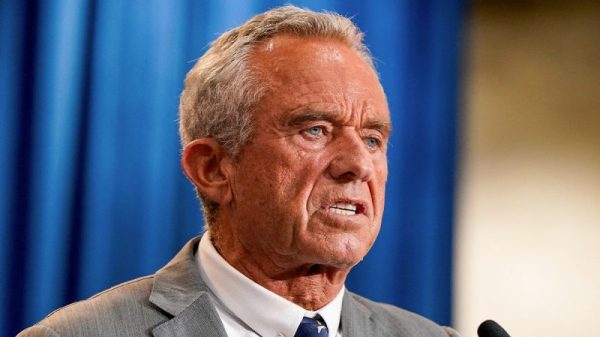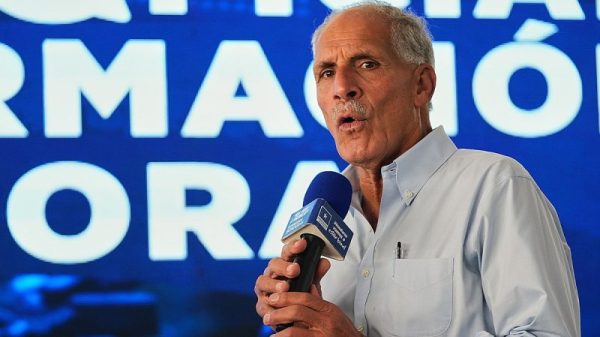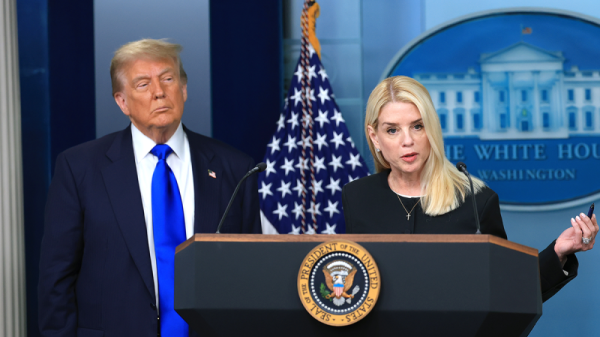Still, that is an improvement: last time, in 2019, it was less than eight cents per dollar, according to data provided by world governing body FIFA and global players’ union FIFPRO.
The gender pay gap will be very much alive and kicking at a tournament which begins on July 20 in Australia and New Zealand.
FIFA announced in June that, for the first time, about $49 million of the record $110 million Women’s World Cup prize money would go directly to individual players — at least $30,000 each for participating and $270,000 to each player on the winning squad.
The rest of the pot is going to be split between participating federations who will decide what share of this money to allocate to teams and players – if any at all. In addition to prize money, FIFA committed to paying $42 million to the federations and players’ clubs for Women’s World Cup preparations.
At the time, he said FIFA was embarking on a “historic journey for women’s football and for equality,” adding that the aim was equality in payments for the men’s and women’s World Cups in 2026 and 2027 respectively.
With its estimated worldwide audience of more than one billion viewers, the Women’s World Cup is one of the biggest sporting events on the planet.
Yet, this year’s edition kicks off in Australia and New Zealand with the sport at somewhat of an inflection point, not least because of the disparity between what women players are paid in comparison to their male counterparts.
Players such as Australia’s Sam Kerr, as well as Megan Rapinoe and Alex Morgan of the US Women’s National Team (USWNT) are celebrated as household names, while England’s Lionesses adorn billboards across the country.
The popularity of the sport is undoubtedly growing, but from Jamaica to Canada, South Africa to Spain, several teams arrive at this tournament having been locked in disputes with their federations.
Despite the huge progress made in recent years, the fight for respect and equity – or sometimes to even be paid at all – continues.
History repeating
When Jamaica’s Havana Solaun threaded the ball into the net against Australia four years ago, she was mobbed by her teammates as they celebrated the first Women’s World Cup goal in their nation’s history.
Having overcome almost every conceivable obstacle – the team disbanded in 2016 before an unlikely heroine, Bob Marley’s daughter, Cedella, came to the rescue – here they were competing at the pinnacle of the sport.
Two months later, the players still hadn’t been paid by the Jamaica Football Federation (JFF). Eventually, they were – but four years on and history is beginning to repeat itself.
Just weeks before their first game, Jamaica’s players released a statement, expressing their “utmost disappointment with the [JFF],” saying that the women’s team had missed several friendly matches due to “extreme disorganization,” and that they had “showed up repeatedly without receiving contractually agreed upon compensation.”
The Reggae Girlz now have a contractual agreement with their national federation, according to Asher, but still had to release a public statement to ensure that they received the best possible support for a World Cup.
“The people holding the torch in [the equal pay] fight are normally the active players and that’s a really vulnerable space to be,” Asher said. “If you’re having to fight against people that are creating opportunities for you to play … it can get really messy.”
An unequal footing
Soccer players’ pay is composed of many different elements: salaries from their club, match fees when representing their national team, prize money and sponsorship. As such, equal pay can become nebulous.
While Morgan and Rapinoe were the highest paid female soccer players last year, earning $5.7 million each on and off the pitch, their most successful male counterpart, Cristiano Ronaldo, was earning $136 million from both on-field and off-field revenue, Forbes estimated.
But Morgan and Rapinoe’s own estimated multimillion-dollar earnings are an outlier at even the highest echelons of the sport.
While top earners’ wages in countries such as the US and France average nearly $250,000 per year, salaries vary greatly between countries and can be less than $600 per month if any at all, according to a 2020 report by global players’ union FIFPRO.
The report also found that, across the board, top female players get paid the same or less in a year than what male soccer players of the same level receive per month.
The Women’s World Cup is an important source of income for players. But many who will be competing over the next few weeks have needed other jobs to sustain themselves.
A FIFPRO report released in June found two thirds of surveyed players reported having to take unpaid leave from another job to play for their national team in World Cup qualifying tournaments, such as the CONCACAF W Championship or the Women’s Africa Cup of Nations.
Almost a third weren’t paid by their national teams at all during these past 18 months, and for those who were paid, it was often dependent on participation and performance, creating instability.
“It’s not like an amusement park, we’re footballers, most of us are pro players,” Asher said, recalling that she worked as a coach at points during her career to help make ends meet.
“This is our career and that deserves compensation and a reward for the work that’s put through,” she said.
According to a 2022 FIFA Benchmarking Report, nearly a quarter (23%) of 225 clubs across 25 national leagues have mainly amateur players, while the rest work with a mix of professionals – who have an official contract with the club and are paid more than their incurred expenses – and amateurs.
More than half (53%) of the surveyed federations still don’t have regulations on players’ minimum wages.
Ahead of the Women’s World Cup, Infantino threatened a tournament broadcast blackout in five major European countries over unacceptable offers of media rights. Though it should be noted that FIFA isn’t short of money – its record-breaking revenue during the 2019-2022 cycle stood at $7.6 billion.
FIFA’s move to introduce individual prize money this year came after more than 150 players from 25 national teams, backed by their global union FIFPRO, sent a letter to soccer’s governing body last October calling for equal conditions and prize money.
“Many players at the Women’s World Cup come into the tournament as amateurs or semi-professional, which undermines their preparation and, in turn, the quality of football we see on the pitch,” said FIFPRO in the letter sent to Infantino in October 2022, adding that many players also had no agreement with their member associations to ensure guaranteed World Cup compensation.
More than simply closing a pay gap
The gender pay gap is typically referred to in monetary terms, measuring how much women earn for every dollar a man earns. But for the players, equal pay encompasses more than simply closing this gap to the salaries enjoyed by male footballers.
“I know that’s not realistic (immediately),” Asher said, highlighting the importance of facilities, scheduling and maternity leave. “Anything that creates space for a professional women’s player to show up and feel just as professional as a man.”
At the beginning of her career, Riley recalled playing in the World Cup was “just for honor,” rather than something that could provide financial security.
“It’s not just the increase in prize money,” she added. “But also, the equal conditions in terms of the delegation size and having single rooms. These are things that you would have thought we would have had a long time ago.”
Meanwhile, Canada’s players told a parliamentary committee in March that the team had been forced to cut training programs and staff, were paid significantly less than their male counterparts in 2021 – the year they became Olympic champions – and that there had been “disregard” for any attempt to establish a women’s domestic league.
And in 2022, when the men’s team qualified for the World Cup for the first time since 1986 and was eliminated in the group stages, Canada Soccer spent even more – $19.5 million on men’s national teams of all ages. The women’s national team qualified for the World Cup too, but their teams only got $14 million.
‘Sexist attitudes’
Such attitudes are deeply entrenched. Until relatively recently, women were not even able to play soccer in several countries around the world.
It was “quite unsuitable for females,” an English Football Association (FA) minute book said in 1921, and the organization banned women from playing at its clubs until 1971. The French Football Federation only recognized women’s soccer in 1970, and the Royal Belgium Football Association a year later.
Even today, most decision-makers in soccer continue to be men – UEFA’s executive committee has 20 members, 19 of whom are men, while FIFA’s Council has 37 members, 30 of whom are men. All but one of those women sitting on those decision-making bodies fill quota seats, specifically reserved for women.
And nearly three quarters (74%) of head coaches across all women’s soccer leagues are still male, with no women at all in top positions in Germany, Iceland, the Netherlands and Norway, according to the 2022 FIFA Benchmarking Report.
“I think it’s a mindset. It’s tradition,” Riley said. “The women’s game is still new.”
‘Our duty to make the sport better’
The recent history of women’s soccer is intertwined with its fight for equal pay and treatment.
Days before the start of the World Cup, England’s Lionesses announced they would put on hold discussions with their federation over performance-related bonuses until the end of the tournament.
Earlier in July, the English Football Association said it will not be paying bonuses to the players for their World Cup performance, on top of the individual prize money pledged by FIFA.
“We are disappointed that a resolution has still not been achieved,” the players said in a statement.
Four years ago, chants of “equal play, equal pay” echoed around the stadium as the USWNT lifted the World Cup trophy.
USWNT players reached an equal pay deal with US Soccer in May 2022, after six years of legal wrangling, dating back to a claim of wage discrimination filed in 2016 by five of the team’s stars – Carli Lloyd, Rapinoe, Morgan, Hope Solo and Becky Sauerbrunn – and a gender discrimination lawsuit that the whole team filed in 2019.
As a result, the USWNT earned more money from its male counterparts reaching the knockout stages of the 2022 World Cup in Qatar than it did from winning its own tournaments in 2015 and 2019.
“For six years, we had been in this fight and nobody wants to be fighting with their employer,” she added. “[But] long gone were the days of thinking that we just need to accept what’s given to us. So it was our duty to fight and to make the sport better … just like all the players before us had done.”
There were different challenges for the generation before Lloyd, the generation who advocated for and participated in the fledgling international tournaments of the late 1980s and early 1990s.
“In the old days, players paid to represent their country,” Reid said, recalling that every player had to contribute $850 when Australia traveled to China for the 1988 FIFA Women’s Invitation Tournament, a pilot World Cup.
While the sport has professionalized since then, those same issues still disfigure it.
“People want to know, what’s the progress been like from the last World Cup,” Asher said. “And I’m like: ‘We’re here doing it again.’”





































